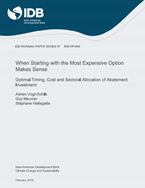When Starting with the Most Expensive Option Makes Sense: Optimal Timing, Cost and Sectoral Allocation of Abatement Investment
Date
Feb 2018
This paper finds that it is optimal to start a long-term emission-reduction strategy with significant short-term abatement investment, even if the optimal carbon price starts low and grows progressively over time. Moreover, optimal marginal abatement investment costs differ across sectors of the economy. It may be preferable to spend $25 to avoid the marginal ton of carbon in a sector where abatement capital is expensive, such as public transportation, or in a sector with large abatement potential, such as the power sector, than $15 for the marginal ton in a sector with lower cost or lower abatement potential. The reason, distinct from learning spillovers, is that reducing greenhouse gas emissions requires investment in long-lived abatement capital such as clean power plants or public transport infrastructure. The value of abatement investment comes from avoided emissions, but also from the value of abatement capital in the future. The optimal leveled cost of conserved carbon can thus be higher than the optimal carbon price. It is higher in sectors with higher investment needs: those where abatement capital is more expensive or sectors with larger abatement potential. We compare our approach to the traditional abatement-cost-curve model and discuss implications for policy design.



